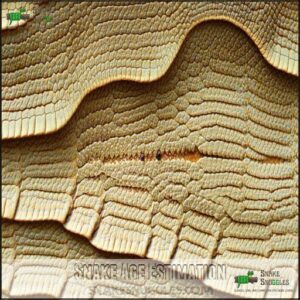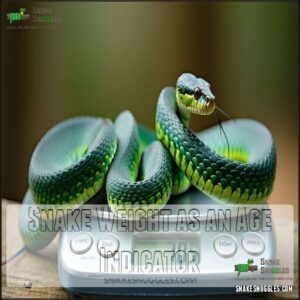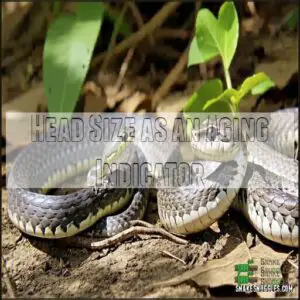This site is supported by our readers. We may earn a commission, at no cost to you, if you purchase through links.
 You can’t tell how old a snake is just by looking at it—unlike trees, they don’t come with convenient growth rings!
You can’t tell how old a snake is just by looking at it—unlike trees, they don’t come with convenient growth rings!
Instead, experts use several methods: measuring length (which varies by species), checking weight, examining scale smoothness, counting shed skins, and observing behavioral maturity.
For captive snakes, good record-keeping is your best friend.
Wild snakes often require special techniques like skeletochronology, where scientists examine bone growth marks.
Remember that growth rates vary dramatically based on feeding, temperature, and health conditions.
The most reliable age indicators combine multiple approaches rather than relying on any single measurement, using a combination of these methods for accurate results, including good record-keeping.
Table Of Contents
- Key Takeaways
- Snake Age Estimation
- How to Tell Snake Age
- Snake Growth Stages
- Physical Age Indicators
- Expert Age Assessment
- Frequently Asked Questions (FAQs)
- What is the age of a snake?
- Can you tell how old a snake’s skin is?
- Is there a way to tell a snakes’ age?
- Do snakes show signs of aging?
- Do snakes recognize their owners?
- How does habitat impact a snakes aging process?
- Can snake markings indicate their specific age range?
- What role do genetic factors play in aging?
- Are there seasonal influences on snake aging patterns?
- Does diet variability affect growth rate and lifespan?
- Conclusion
Key Takeaways
- You can’t determine a snake’s age by looking at it alone—instead, you’ll need to combine multiple indicators like length, weight, scale texture, and head structure for the most accurate estimation.
- Unlike mammals, snakes hide their age well, with factors like feeding history, environmental conditions, and species variation dramatically affecting their growth rates and development.
- As your snake ages, you’ll notice physical changes including fading color patterns, more defined head structure, decreased shedding frequency, and possibly "salt and pepper" speckling on older specimens.
- For the most reliable age assessment, you should consult veterinarians or experienced breeders who can recognize subtle age indicators, and if you have a pet snake, maintain detailed records from day one.
Snake Age Estimation
You’ll need more than just size to determine your snake’s true age, as factors like species, feeding history, and environmental conditions all affect how quickly they grow.
Unlike mammals with their telltale signs of aging, snakes keep their secrets well hidden, making expert methods essential for accurate age estimation, and it’s clear that accurate age is crucial for understanding their development.
Snakes hide their age well, but expert methods unlock crucial clues to understand their growth, care needs, and overall development.
Factors Affecting Snake Age
Why is determining a snake’s age so challenging?
Unlike mammals, snakes are affected by numerous factors that influence their growth and aging process:
- Feeding History – Well-fed snakes grow faster than undernourished ones
- Environmental Conditions – Temperature and humidity affect development rates
- Species Variation – Different species age at dramatically different rates
- Genetic Factors – Individual genetics can substantially impact growth patterns
Even experienced keepers often struggle with snake age estimation because these snake aging indicators vary so widely.
Importance of Accurate Age Estimation
Knowing your snake’s age isn’t just interesting—it’s practical.
Accurate snake age estimation helps you provide proper care suited to their life stage.
Young snakes need different environments than seniors.
Identifying health issues becomes easier when you understand age-related changes.
Plus, snake age determination contributes to longevity studies, improves breeding programs, and expands overall species knowledge.
Whether you’re a new owner or experienced handler, understanding snake aging helps guarantee your scaly friend enjoys their full lifespan.
Challenges in Determining Snake Age
While accurate aging helps with proper care, you’ll face several roadblocks when trying to determine snake age.
Without knowing the hatch date, estimating snake age becomes largely imprecise. Feeding history dramatically impacts growth rates – well-nourished snakes grow faster than undernourished ones.
Individual variation makes standardized aging difficult, and environmental factors like temperature and habitat quality further complicate snake age estimation.
One key indicator is observing their shedding frequency, which decreases with age, and it’s a crucial factor in determining snake age. It’s like trying to guess someone’s age without knowing their birthday, which highlights the importance of accurate aging for proper care and understanding snake growth.
How to Tell Snake Age
You’ll need to look beyond just size to determine your snake’s age, as factors like coloration, head structure, and species-specific traits provide more reliable clues.
By combining multiple indicators such as scale texture, feeding history, and potential physical changes like faded patterns or "salt and pepper" speckling, you can make a more educated estimate of how many years your slithery friend has been around.
Length and Weight Considerations
Your snake’s size offers clues about its age, but it’s not a straightforward formula. While length and weight provide helpful indicators, they can be deceiving without context.
- Growth rate varies dramatically based on feeding impact and environmental conditions
- Body condition matters more than absolute weight when estimating age
- Regular snake measurement tracking reveals patterns that improve age estimation accuracy
Remember, a well-fed juvenile may outsize an underfed adult! Younger snakes also have a higher shedding frequency.
Head Size and Color Patterns
While length and weight offer clues, a snake’s head shape reveals much about its age.
As your snake grows older, you’ll notice its head becoming broader and more defined.
Color patterns also change over time – older snakes typically display fading colors and rougher skin texture.
These snake age signs aren’t foolproof, but when combined with other indicators, they help with snake age estimation.
Remember, spot development and scale changes are subtle but telling features.
Species-Specific Age Estimation Methods
While head characteristics offer clues, different species need specific aging approaches.
Rattlesnake rattle count provides rough estimates, with 2-3 rattles typically added yearly. Python growth patterns follow distinct trajectories based on feeding history.
Albino fatty lumps may develop in older specimens. Research on species unique traits continues to refine snake age estimation methods.
For accuracy, combine multiple indicators when determining your snake’s maturity—no single method works for all species, and it’s crucial to consider species unique traits and refine snake age estimation.
Snake Growth Stages
You’ll find that snakes progress through distinct growth stages that offer valuable clues about their age, from rapid-growing hatchlings to slow-maturing adults.
Understanding these stages helps you make more accurate age estimates, as each phase has unique physical characteristics that trained eyes can identify.
Hatchling Stage Characteristics
During the hatchling stage, newly emerged snakes display distinctive characteristics that provide clear age indicators.
After their First Shed, you’ll notice these tiny reptiles still have a visible Umbilical Scar, which gradually fades over time.
Your new snake hatchling will demonstrate:
- Enthusiastic Initial Feeding behaviors within days of hatching
- Rapid Growth Rate compared to older snakes
- Heightened Vulnerability to environmental conditions
These features help differentiate hatchlings from juvenile snakes in their early snake development, characterized by distinctive characteristics and an overall Heightened Vulnerability.
Juvenile Stage Growth Patterns
While hatchlings require special care, juvenile snakes enter a remarkable growth phase.
You’ll notice your juvenile snake’s rapid development through frequent shedding—a clear indicator of its growth rate.
During this stage, snakes can double their length in just nine months when conditions are ideal!
Environmental impact and hatchling diet directly influence snake growth rate.
The snake shedding cycle is most frequent now, with juveniles shedding several times yearly as they experience growth spurts.
Adult Stage Aging Process
Once your snake reaches adulthood, it’ll show subtle aging signs you might miss without knowing what to look for.
Adult snakes typically experience color fading and develop distinctive skin markings like fine speckling.
Their head structure becomes more defined and chunky, while very elderly specimens may show muscle reduction.
You’ll also notice decreased activity levels in aging snakes – they often become more sedentary and less interested in exploration compared to their younger counterparts.
Physical Age Indicators
You’ll discover several physical clues that can help determine your snake’s age, including subtle changes in coloration, head structure, and scale texture.
While no single indicator gives an exact age, combining observations of length, weight, head size, and color patterns will provide you with a more accurate estimate of how many years your slithery friend has been around, considering factors like subtle changes.
Snake Length and Its Relationship to Age
Despite what many think, a snake’s length isn’t a perfect age predictor.
While growth patterns follow general trends, factors like diet, genetics, and environment heavily influence growth rates.
Different species reach vastly different maximum snake lengths too.
For accurate snake age estimation, measure consistently from nose to tail tip, but remember—a corn snake at 5 feet might be 3 years old, while a similarly-sized ball python could be 7!
Understanding factors impacting development is fundamental to grasping that a snake’s age can vary greatly depending on its species and growth rates.
Snake Weight as an Age Indicator
While length gives you a general idea, weight provides additional clues about your snake’s age.
However, weight fluctuation makes this method tricky. Underfed snakes appear younger, while overfed ones might seem older than they actually are.
Gram measurements don’t consistently correlate with age since feeding impact varies widely. A healthy 3-year-old ball python on a regular diet will weigh differently than one with irregular meals, complicating snake age estimation.
Accurate readings require a precise scale for snakes.
Head Size as an Aging Indicator
As your snake ages, its head shape changes in subtle but noticeable ways.
You’ll often see a more pronounced, chunky head structure in older snakes compared to juveniles.
While head size limits are partly determined by genetics, diet effects also play a role.
Different species head variation makes this a useful snake age indicator, though not definitive.
When combined with other snake aging signs, head size provides valuable snake age clues.
Observing shedding frequency changes can also provide insights into a snake’s age, and help determine its developmental stage, and overall health condition.
Changes in Color Patterns Over Time
Beyond head size, your snake’s coloration offers valuable aging clues.
As they mature, many species display fading coloration and subtle changes in pattern complexity.
You’ll notice markings development becoming more defined or, conversely, colors becoming duller with age.
Scale pigmentation often shifts gradually, with some snakes developing "salt and pepper" speckling.
Color mutations may age differently, but most snakes exhibit these snake aging signs, making coloring an important factor in identifying snake age characteristics, and understanding aging clues is crucial.
Expert Age Assessment
You’ll get the most accurate snake age assessment by consulting professionals who examine multiple factors like growth patterns, physical changes, and species-specific traits.
Veterinarians and experienced breeders can analyze subtle indicators such as head structure, skin texture, and behavior that you might miss, giving you a clearer picture of your serpent’s true age, based on their expertise in recognizing complete concepts.
Role of Veterinarians in Determining Age
When examining your snake’s age, veterinarians bring specialized expertise that goes beyond basic observations.
Through detailed health assessments, vets can evaluate growth patterns and physical development indicators that reveal age clues.
They’ll check for subtle signs in scale quality, muscle tone, and organ function during examinations.
For specialized needs, consider exotic pet supplies for superior care.
Your vet’s species knowledge allows for more accurate snake age determination, especially when combined with care recommendations for age-appropriate feeding and habitat adjustments.
Expertise of Breeders in Snake Aging
Many professional breeders have developed an almost sixth sense for snake age estimation through years of hands-on experience.
When you consult a breeder, they’ll evaluate multiple snake maturity indicators including size proportions, behavior patterns, and color development.
Their breeding records provide valuable historical data about genetic factors and morph influence.
Most reputable breeders maintain detailed documentation of their snakes’ developmental milestones, making their expertise invaluable despite the ethical considerations surrounding age verification methods.
Assessing Shed Snakeskin for Age Clues
While examining shed snakeskin, you’ll find subtle clues about a snake’s age.
Shedding frequency decreases as snakes mature—younger ones shed every few weeks, while adults might shed just 2-4 times yearly.
Look for pattern fading and reduced skin elasticity in older specimens.
Scale characteristics change over time, and scar visibility increases with age.
Skin regeneration occurs during shedding, contributing to this process.
Unlike tree rings, snake sheds don’t provide exact aging methods, but they’re valuable indicators nonetheless.
Frequently Asked Questions (FAQs)
What is the age of a snake?
Like rings inside a tree trunk, your snake reveals its age in subtle ways.
You’ll need to take into account size, physical characteristics, and behavior—though without knowing the hatch date, you’re making an educated guess.
Can you tell how old a snake’s skin is?
You can’t precisely determine a snake’s skin age, but you’ll notice older shed skins often show more wear, discoloration, and potential damage.
Snake skin doesn’t contain reliable age markers like growth rings.
Is there a way to tell a snakes’ age?
While 90% of snake owners can’t accurately determine their pet’s age, you can’t rely solely on size.
Instead, look for subtle clues like head structure, skin patterns, activity levels, and feeding habits for a rough estimate of their age, considering factors that provide a more accurate determination, such as subtle clues.
Do snakes show signs of aging?
Yes, snakes do show signs of aging.
You’ll notice their skin becoming duller, "salt and pepper" dots appearing, their head structure growing more defined, and possibly decreased activity levels and appetite as they get older.
Do snakes recognize their owners?
Similar to cautious observers, snakes don’t truly recognize owners but may tolerate your scent and handling.
They’re responding to routine, not forming emotional bonds.
You’re familiar, not a friend to them.
How does habitat impact a snakes aging process?
Your habitat directly impacts your snake’s aging process.
Proper temperature, humidity, and space allow for normal growth, while poor conditions can stunt development or cause premature aging.
You’ll notice healthier shedding in well-maintained environments, which is a key indicator of a snake’s overall health and well-maintained environment.
Can snake markings indicate their specific age range?
Like tree rings telling a forest’s story, a snake’s markings can offer clues about its age range, but they’re not definitive timekeepers.
You’ll notice fading colors and subtle texture changes with advancing years, which can be a subtle indicator of age.
What role do genetic factors play in aging?
Genetic factors set the pace for a snake’s growth, shedding cycles, and lifespan.
They influence how quickly it matures, its size potential, and even age-related traits like skin texture or color changes, which can be considered complete concepts.
Are there seasonal influences on snake aging patterns?
Seasons weave their magic into snake aging like invisible threads.
Your snake’s growth slows during brumation periods, while active seasons accelerate development.
These cyclical patterns can impact metabolism, shedding frequency, and overall aging process.
Does diet variability affect growth rate and lifespan?
Your snake’s diet absolutely affects its growth rate and lifespan.
Consistent, appropriate feeding helps your pet grow steadily, while overfeeding accelerates growth but can reduce lifespan.
Underfeeding stunts development and compromises long-term health.
Conclusion
Ironically, these mysterious tubular reptiles don’t come with convenient date stamps.
When wondering how can you tell how old a snake is, remember that combining multiple methods yields the most accurate results.
Whether you’re measuring length, examining scale condition, or consulting with experts, each approach provides valuable clues.
For pet snakes, maintain detailed records from day one.
While no single technique is foolproof, these seven methods will help you make an educated estimate of your slithery friend’s age, and by using them, you can gain a better understanding of your snake’s age and develop a stronger bond with your slithery friend.
















